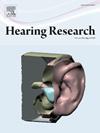清醒豚鼠在过度压缩音乐下的听觉变化
IF 2.5
2区 医学
Q1 AUDIOLOGY & SPEECH-LANGUAGE PATHOLOGY
引用次数: 0
摘要
全世界的卫生机构都认为,在闲暇时间暴露于巨大的声音是影响听力的一个重要风险因素。定义不安全暴露的现行标准基于等能量假说,根据该假说,建议的最大暴露量是音量和每日暴露时间之间的权衡,这是一个令人满意的方法,但枪声等强烈的非高斯强音除外。如今,音乐和视频会议流媒体服务播放的声音广泛使用数字动态范围压缩。通过填充信号中长达毫秒的波谷以防止竞争噪声的掩盖,它使声级统计偏离了高斯分布,而高斯分布正是等能量假说产生的框架。在法国法规允许的 102 dBA 平均声级下,对两组豚鼠进行了听觉效果比较,比较结果显示,豚鼠在 4 小时内接触相同音乐时,要么接触原版音乐,要么接触过度压缩版音乐。除了在最低的两个频率(2 和 3 千赫)上的耳声发射出现暂时性偏移外,在暴露后 1 天、2 天和 7 天的监测中,音乐暴露对耳蜗没有任何可检测到的影响。与此相反,中耳肌肉强度的表现却不同,暴露于原始音乐的一组在暴露一天后已完全恢复,而暴露于过度压缩音乐的一组即使在 7 天后仍停留在基线的 50%左右。然后,将样本重新暴露于与第一次相同的音乐中,并牺牲样本进行内毛细胞突触密度测定。与未接触音乐的对照组相比,两种音乐的突触密度均无差异。目前的研究结果表明,同一首音乐在播放原始版本时是无害的,但当过度压缩到同一水平时,会诱发一条听觉神经通路的长期障碍。所诱发的障碍似乎与内毛细胞突触无关。本文章由计算机程序翻译,如有差异,请以英文原文为准。
Auditory changes in awake guinea pigs exposed to overcompressed music
Exposure to loud sound during leisure time is identified as a significant risk factor for hearing by health authorities worldwide. The current standard that defines unsafe exposure rests on the equal-energy hypothesis, according to which the maximum recommended exposure is a tradeoff between level and daily exposure duration, a satisfactory recipe except for strongly non-Gaussian intense sounds such as gunshots. Nowadays, sound broadcast by music and videoconference streaming services makes extensive use of numerical dynamic range compression. By filling in millisecond-long valleys in the signal to prevent competing noise from masking, it pulls sound-level statistics away from a Gaussian distribution, the framework where the equal-energy hypothesis emerged.
Auditory effects of a single 4 hour exposure to the same music were compared in two samples of guinea pigs exposed either to its original or overcompressed version played at the same average level of 102 dBA allowed by French regulations. Apart from a temporary shift of otoacoustic emissions at the lowest two frequencies 2 and 3 kHz, music exposure had no detectable cochlear effect, as monitored at 1, 2 and 7 days post-exposure. Conversely, middle-ear muscle strength behaved differentially as the group exposed to original music had fully recovered one day after exposure whereas the group exposed to overcompressed music remained stuck to about 50% of baseline even after 7 days. Subsamples were then re-exposed to the same music as the first time and sacrificed for density measurements of inner-hair-cell synapses. No difference in synaptic density was found compared to unexposed controls with either type of music.
The present results show that the same music piece, harmless when played in its original version, induces a protracted deficit of one auditory neural pathway when overcompressed at the same level. The induced disorder does not seem to involve inner-hair cell synapses.
求助全文
通过发布文献求助,成功后即可免费获取论文全文。
去求助
来源期刊

Hearing Research
医学-耳鼻喉科学
CiteScore
5.30
自引率
14.30%
发文量
163
审稿时长
75 days
期刊介绍:
The aim of the journal is to provide a forum for papers concerned with basic peripheral and central auditory mechanisms. Emphasis is on experimental and clinical studies, but theoretical and methodological papers will also be considered. The journal publishes original research papers, review and mini- review articles, rapid communications, method/protocol and perspective articles.
Papers submitted should deal with auditory anatomy, physiology, psychophysics, imaging, modeling and behavioural studies in animals and humans, as well as hearing aids and cochlear implants. Papers dealing with the vestibular system are also considered for publication. Papers on comparative aspects of hearing and on effects of drugs and environmental contaminants on hearing function will also be considered. Clinical papers will be accepted when they contribute to the understanding of normal and pathological hearing functions.
 求助内容:
求助内容: 应助结果提醒方式:
应助结果提醒方式:


